This was published 5 years ago
Dining on Oceania Marina, French celebrity chef Jacques Pépin: What does it take to serve 'the finest cuisine at sea'?
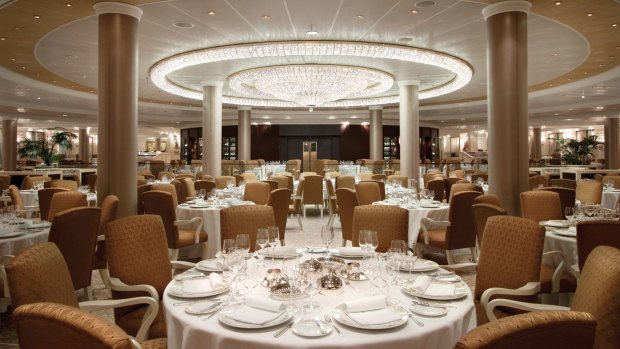
Grand Dining Room, Oceania Cruises' Marina.
How hard is it to deliver good food at sea? For centuries, sailors were happy just to survive scurvy, avoid weevils and to sink their teeth into an occasional fresh banana or slaughtered turtle to alleviate the monotony of salted pork and sea biscuits. Taking the historical perspective, I'd say any cruise ship has fabulous food. To carp that your croissant isn't quite crispy enough while plunging across the Pacific Ocean is a fall down the unedifying rabbit hole of First World problems.
Still, when your slogan is "The Finest Cuisine at Sea" – with all those capital letters and a trademark sign for added gravitas – then you need to deliver something particularly special. And that isn't actually that easy. Oceania tries exceedingly hard to make it happen. Onboard Marina, half the staff of 800 work in its restaurants. That's one staff member for every three guests (Marina carries 1250 passengers) dedicated to the dining experience. Some of its chefs have worked for the world's top hotels and culinary legends such as Paul Bocuse. French celebrity chef Jacques Pepin oversees the cruise line's menus.
Chefs face particular challenges at sea. They must contend with cramped galleys and minimal preparation space, produce many more dishes than your average land restaurant, serve hundreds more people, and manage a multinational crew. They have to use sharp knives on lurching surfaces, and be aware how salt air affects pastry dough.
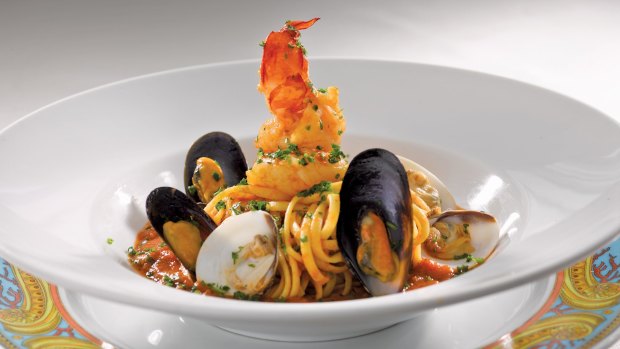
Braised oxtail salad from Jacques restaurant on Oceania Cruises Marina.
Chefs at sea must also order ingredients months in advance, and have awkward provisioning issues. "Delivery in ports such as Barcelona or Miami is easy, but it can be hard in smaller ports," says Marina's senior executive chef, Laurent Trias. "Fruit can spoil in the heat in transit. And sure, I can disembark and see nice mangoes in the market, but I can't just buy two – I'll need a thousand kilos. I once had to fly strawberries from Los Angeles to Fiji at an outrageous cost and some accountants were rather annoyed. But I needed my strawberries!"
Marina is fortunate to have decent storage space. Twelve people are tasked solely with delivering supplies across the ship's restaurants and checking supply levels and freshness. On a typical cruise, the ship carries 3700 kilograms of beef, 4600 kilograms of chicken, more than 500 kilograms of salmon, 7500 litres of milk and 5400 pieces of Belgian chocolate.
No surprise, then, that this ship is known for its food. Marina will amply please the gourmet minded, and you'll want to pick a 10-day cruise to fit in all the dining venues and allow for a repeat eat of Polo Grill's cider-marinated pork belly, or Red Ginger's miso-glazed seabass, surely the most apparently simple, utterly scrumptious piece of fish on any cruise ship.
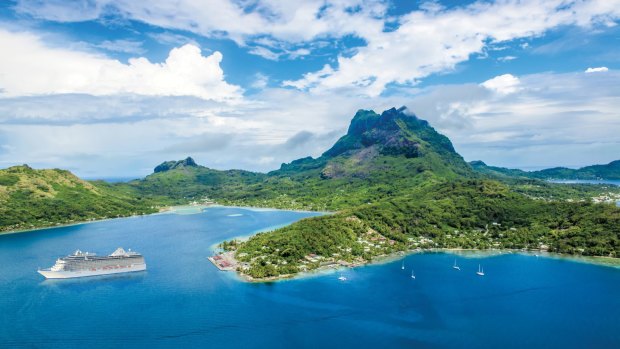
Oceania Marina in Bora Bora.
Many ships have a pan-Asian restaurant these days and most (from an Australian perspective at least) just don't deliver big, flavoursome, authentic dishes. Marina's Red Ginger takes a wide wander across the continent yet seldom falters, and is praised by every passenger I encounter. Oceania says it gets more requests for repeat visits to this specialty restaurant than any other. Signature seabass aside , the spicy duck and watermelon salad, and Thai beef salad are utterly delicious. Lobster pad thai is the most-ordered dish on the ship.
Red Ginger's decor is sexy and understated. It has no windows and favours red, black and contemporary artworks. I imagine Uma Thurman might emerge with a ninja fighting-stick, but instead, friendly wait staff proffer a selection of chopsticks in a lacquer box, and pour orange pekoe from a pretty teapot.
There's an impressive tea selection – hand-rolled gunpowder green tea, Japanese pear tea – and you never get the feeling that Marina stints on quality. Baristas Cafe serves Illy coffee made by actual Italian (and occasional Filipino) baristas. France's famous Viron flour is used for baguettes, Normandy butter for pastries. The Spanish ham comes from acorn-fed pigs, the beef is dry-aged black Angus with the highest USDA grade. On other cruise ships you get scallops, lobster and foie gras only in paid-for restaurants. On Marina, you can have a surfeit.
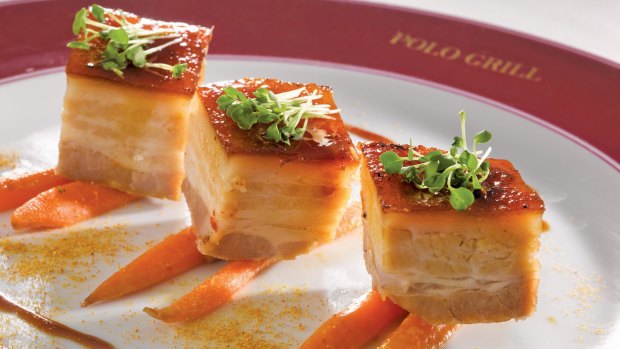
Slow-roasted pork belly from Polo Grill, Oceania Marina.
Lobster tails and scallops make regular appearances in buffet venue Terrace Cafe, where sushi and sashimi are evening standards. You can munch your way from mushroom tarts to salmon tartare with wasabi cream, walnut and blue-cheese salad to duck soup or Dover sole. Terrace Cafe has the most stylish food of any ship buffet, mostly prepared to order or in small batches. Its dessert selection is invariably irresistible. The pastry chef deserves a Legion of Honour for his tarts and mousses and cream puffs that float in your mouth like baroque clouds.
You might think all this fine food comes at a cost, but Oceania has a reasonable price point. Whereas many luxury cruise lines are moving towards an all-inclusive ethos, with Oceania, you'll pay extra for wine with meals (and alcohol generally), shore excursions and gratuities, though not for dining in its specialty restaurants. Yet ships with open bars have to balance the budget somehow, and that's often by reducing their food bill. Big drinkers may think that a reasonable compromise. Foodies, though, will be happy with Marina's morning wellness smoothies, great bread and cheese selections, upmarket dishes, and white-gloved afternoon teas on the Horizons Lounge, during which four-tiered pastry carts do the rounds.
What else? The Grand Dining Room, the main dining venue, has nightly four-course feasts, with good alternative health and vegetarian options. Specialty dining options include Italian venue Toscana and Polo Grill for classic steakhouse and seafood dishes. Both are very good, though neither wow-inducing. When you're ready for something simpler, Waves Bar offers burgers, hot dogs and good ice-creams. It's a notch above most pool bars, offering wagyu beef, lobster medallions and slow-cooked pork belly.
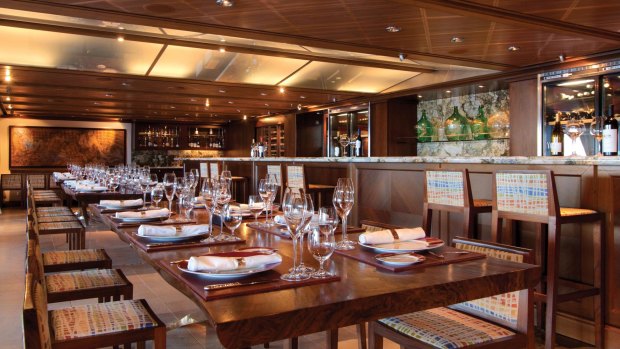
La Reserve dining area on Oceania Cruises' Marina.
So, does Marina offer the finest cuisine at sea? Yes, if you choose your dining venues and dishes well. Some things are just odd, like the lettuce masquerading as "Asian greens'" at Red Ginger, or Toscana's chocolate lasagne. For me, Jacques is the most disappointing specialty restaurant, its food not surpassing that of other French restaurants at sea, and rather unimaginatively plated. Two bistro classics, escargots and onion soup, don't inspire, though the coq au vin does a tango with my taste buds.
The French fare at La Reserve, on the other hand, is outstanding. This is the only dining venue on Marina at a supplement, offering three seven-course tasting menus matched with French wines – including a grand cru classe and an interesting, silky Cotes de Nuits – curated by the prestigious Wine Spectator magazine.
Only 24 guests sit down to dine, with courses announced and plated in front of you by the chefs themselves. My "Cuisine Bourgeoise" menu explored classic 19th-century French flavours, starting with a chicken veloute that would have delighted angels, and moving on through lobster souffle made with blue-shelled, cold-water Brittany lobster, fillet of sole with truffles, beef tenderloin and a nut-crusted brie. The final baked Alaska (or Siberian omelette, as the French call it) is a sensation, studded with Williams pears and chestnut ice-cream. It's a long way from sea biscuits, and amply justifies Oceania's culinary claims.
Oceania Cruises' Marina sails worldwide. The ship will be in the Mediterranean in the second half of 2018 before moving to South America in November. In January 2019, Marina sails several itineraries in French Polynesia before heading north towards New York and back across the Atlantic to Europe for a long summer 2019 season. The writer sailed a 10-day Sparkling South Pacific itinerary round-trip from Papeete. From $3450 a person, including all restaurant venues except La Reserve. Phone 1300 355 200. See oceaniacruises.com
Sign up for the Traveller Deals newsletter
Get exclusive travel deals delivered straight to your inbox. Sign up now.